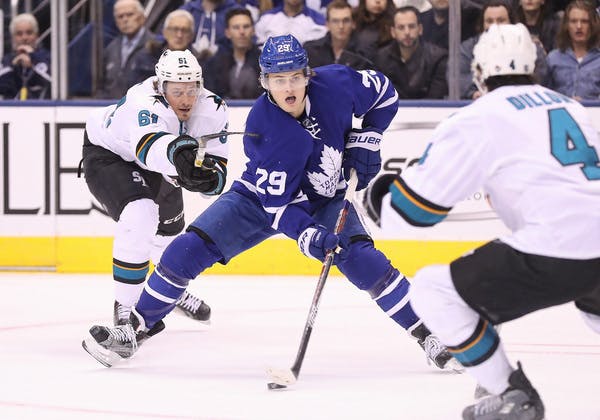Even if the Leafs wanted to trade Nylander (which they don’t), this summer would be the worst time (so they definitely won’t)

By Ryan Fancey
4 years agoWhen you’re shooting the breeze about NHL player contracts and potential trades, a lot of times two pretty frustrating concepts get overlooked. One is the difference between RFA years and UFA years; People commonly try to compare a player’s contract when the salary is heavy on the former versus one exclusively buying up the latter. The other is the relatively simple philosophy of trying to buy low and sell high in player transactions, essentially factoring in inflated or unlucky shooting percentages and the like. These are common misunderstandings because, well, not everyone spends their time poring over CapFriendly for hours or digging up language from the NHL/PA collective bargaining agreement.
But even for casual hockey fans, you have to appreciate this stuff on some level to get a grasp on why the Leafs are not moving on from William Nylander later this summer. Just cut the bullshit already.
We don’t need to fully re-hash the whole Nylander contract situation from a few months back, but the short hand of it is that he settled on a deal worth $6.96-million AAV for six years (prorated in the first due to time missed). He then played 54 games, turning in boxcar production of 7 goals and 20 assists – a 41-point pace over 82 games, for a player who had already hit 60+ twice leading up to this whole thing.
And that’s all a lot of people needed to see. $6.96 million for 27 points. A disaster season at worst, an unfortunate one at best.
Now I can run out a number of reasons why under the surface Nylander wasn’t nearly as bad as his production indicated, but is there even any point? I mean sure, his Expected Goals (xG) per hour was fourth among forwards, ahead of Kapanen, Kadri, Johnsson and even Marner. But no one wants to hear about that (never mind that the Leafs blatantly use an xG model). And yeah, he was tops on the team in terms of on-ice xG differential, literally the best at 5v5. But who cares, right? Only 7 goals in 54 games. Nearly a million dollars per goal. That’s what every armchair GM is hanging their hat on, and they want Nylander gone. Right now.
| Forward | 5v5 On-Ice xG Diff / 60 |
| Nylander | 0.58 |
| Hyman | 0.5 |
| Tavares | 0.47 |
| Marner | 0.36 |
| Matthews | 0.09 |
This obviously isn’t to say Nylander is better than all these players listed. He isn’t. But the ice was tilted in the right direction with him out there, and the Leafs had a better chance of scoring than being scored against. To suggest he played poor defensively or had lost a step really didn’t show up in the numbers.
The puck just wasn’t going in.
| Forward | 5v5 xG | Goals Above xG |
| Tavares | 1.18 | 0.4 |
| Matthews | 1.17 | 0.17 |
| Hyman | 1.0 | -0.16 |
| Nylander | 0.97 | -0.47 |
| Kapanen | 0.88 | -0.1 |
The thing is, even if you threw out all these metrics that show Nylander got unlucky and will be just fine in the long run, the idea of trading him comes down to something far more simple: The buy low/sell high approach to managing trade assets mentioned above. To move Nylander this summer would be to go in the total opposite direction of that. It’s just flat-out dumb.
Since he was drafted in 2014, Nylander’s stock or perceived value has never been lower than it is right now. His xG was 0.97 per hour, but his actual output was 0.5, the biggest gap anyone on the Leafs experienced this season. As far as “fighting the puck” or whatever other term you want to pin to bad luck goes, it couldn’t really have gone worse for Nylander this year. But the skill is still there.
Trading a player on the heels of a tanked shooting percentage is almost as dumb as blowing money on a free agent who uncharacteristically just shot the lights out. Nylander’s previous three seasons leading up this one saw him convert at rates of 14.8% (a short call-up), 10.8%, and 10.9%. This season? Dipped, or I should say cratered, to 5.4%.
And perhaps there are some, you know, human reasons for this: The holdout and layoff could have messed with Nylander getting his timing back, he just couldn’t settle in to any sort of rhythm. The zip on his shot took some time to get there. It’s not unfair to speculate on that.
But none of that matters when we’re talking about trading this guy. You simply don’t look for returns on a 23-year-old player with star potential that just had by far his unluckiest season, and that’s why the Leafs won’t do it. If people want to continue to kick around this idea of trading him a year from now when Nylander pours in a 70-point season, by all means. It probably won’t happen then either, but at least there’d be an ounce of common sense involved.
[All xG numbers via MoneyPuck.com]
Recent articles from Ryan Fancey





